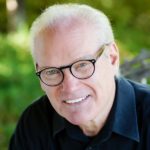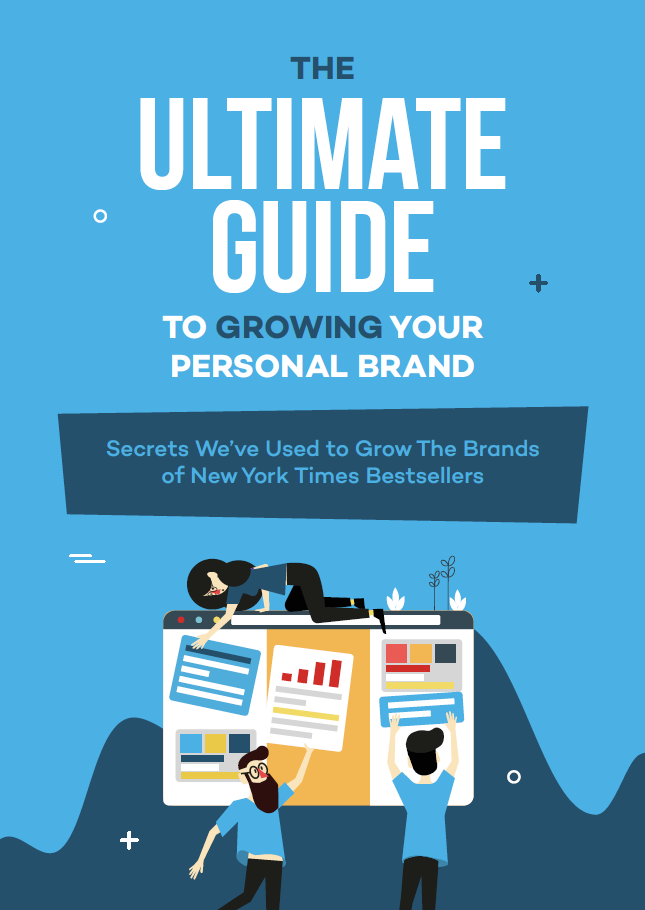Ever wonder why certain personal brands become wildly successful and some never get off the ground?
I have.
In fact, for a long time, I thought building a personal brand that actually caught on was the equivalent of winning the lottery.
A few fortunate souls received a golden ticket—and the rest didn’t.
But luckily, I was wrong.
The truth is:
Every successful personal brand out there followed a proven framework, whether they know it or not.
Each person—from Tony Robbins to Ramit Sethi—made intentional, deliberate decisions that grew their brand to the level it’s at today.
Don’t hear me wrong though…
I’m not implying there’s a step-by-step process everyone can follow to become the next Tim Ferriss.
The road to a multi-million dollar personal brand looks completely different for everyone.
But I am saying this:
There are certain proven principles you can apply to grow your personal brand that have been used to perfection by every successful personal brand ever created.
And in this post, I’ll tell you exactly what those principles are and how the pros use them, so you can take advantage of them to grow your personal brand.
Need help building your personal brand? Click here to get a copy of our ultimate guide that reveals secrets we’ve used to grow the brands of New York Times Bestsellers.
Top Personal Brand Examples and Why They’re Successful
1. Jerry Jenkins
Author of the Left Behind Series | 21-Time New York Times Best Seller | Online Writing Coach
One of the most important elements of a rock-solid personal brand is authority—your experience and expertise in your area of focus.
Jerry Jenkins is about the best example of expertise you can find.
A few years ago, Jerry decided to build his online presence, so he could become a virtual coach for aspiring writers across the world.
Part of what made this venture a success is his unmatched experience in the world of writing.
Here’s a short list of his accolades:
- He’s written 195 books (including the Left Behind series and biographies for the likes of Joe Gibbs, Walter Payton, and Hank Aaron).
- He’s sold over 70 million copies of those books in total.
- He’s worked in the publishing industry.
- 21 of his books have become New York Times best sellers. (Yes, you read that correctly.)
Few people who have ever lived can come close to those achievements.
His authority in the industry makes him more than qualified to give aspiring writers advice.
All successful personal brands have some level of expertise, experience, and unique insight when it comes to their niche.
Does that mean you need “Jerry levels” of authority before you build your brand?
Absolutely not.
But you do need to have some level of authority to succeed—whether that’s unique insight, experience, or testimonials from others with authority in your niche.
You need authority in order to build trust with your audience.
But as we both know, you can’t build a massive personal brand online off authority alone. So, what else does Jerry do?
Pay attention because this is super important…
He freely shares some of his best content.
You can see this right off the bat by looking at his homepage.
Jerry lists 6 incredibly in-depth guides he wrote on everything from writing a book to getting published that anyone can access for free.

Now, I know what you’re thinking…
“Why would I ever give away my best content for free?! I have a family to feed!!”
Simple. There are 4 huge (I mean HUGE) reasons:
- It helps you build your authority, because you’re proving to your audience you know what you’re talking about.
- It allows you to give before you get from your audience—which wows your audience and helps you build a loyal following.
- Building off of the last point, it makes your audience much more likely to become paying customers when you have a product to offer them.
- You can drive enormous amounts of traffic to your blog with incredible, in-depth content. (For example: With our help, Jerry’s content ranks in top positions on Google, which get him over 120,000 qualified site visitors each and every month.)
Other Personal Brand Examples Who Do This Well
2. Brian Dean
SEO Expert | Founder of Backlinko
Another key element every top personal brand has is specificity of focus. In other words, they’re well-known for their expertise in a specific niche.
Why is this important?
A few reasons:
- Associating your name with a specific niche builds your credibility and authority.
- It attracts more specific people (who are more likely to turn into customers) to your website and social profiles.
- It makes it wayyy easier to map out your content calendar.
One of the top examples of specificity in a personal brand you can find is Brian Dean, founder of Backlinko.
The Backlinko blog is dedicated to teaching people how to get more website traffic from search engines.

And that’s all he focused on for 5-6 years. This allowed him to:
- Be seen as an expert by everyone in the SEO industry.
- Achieve top rankings in Google for about every SEO-related search you can think of.
- Build a successful flagship course that sells for $997.
- And build a massive following of entrepreneurs and marketers who want to learn SEO.
This dedication to specificity definitely paid off for Brian.
But that’s not all we can learn from him…
In 2018, Brian decided to expand his reach into an adjacent niche: teaching YouTube SEO.
“But I thought you said we need to focus on one specific thing? Did Brian break the rules!?”
You’re right. I did say that, but no he didn’t. Keep reading.
Brian didn’t just pick a niche out of a hat. He didn’t say, “Oh, I like fantasy football, so I’m going to be the fantasy football guy now!”
He made a strategic move to grow his business.
After dominating his original niche, he expanded into a closely related niche—one in which he could become the “go-to guy” without sacrificing everything he’s already built.
Teaching YouTube SEO makes a ton of sense for Brian, because it’s:
- Very closely related to plain ole’ SEO from a topic standpoint
- One of the latest hot topics in marketing
- Something he was already dominating for his own brand
If he would’ve reached for a market that wasn’t closely related to SEO (like affiliate marketing or marketing automation), he would have diluted his brand.
Backlinko’s story gives us a proven blueprint for how to start and grow a specific, focused, and (most importantly) successful personal brand.
Other Personal Brand Examples Who Do This Well
Need help building your personal brand? Click here to get a copy of our ultimate guide that reveals secrets we’ve used to grow the brands of New York Times Bestsellers.
3. Ramit Sethi
Online Entrepreneur | Founder of I Will Teach You to Be Rich and Growth Lab
Personal brands thrive off having and keeping people’s attention.
It’s literally the lifeblood of the business.
No attention = No sales.
No sales = No money.
No money = No business.
But how do you actually get people’s’ attention—especially in a world that avoids ads, emails, and pop-ups like the plague?
By delivering a unique message with a distinct voice.
And Ramit Sethi does this better than just about anyone else.
I Will Teach You to Be Rich was born from a frustration with conventional financial advice from “experts”.
Ramit explains on his about page that all the experts talked about making a budget and cutting back on lattes, but no one was actually taking their advice.
He decided to change that.
After running experiments, he discovered that people don’t need more information about personal finance.
What they really need is a way to “master the psychology and systems that will help us do what we already know we need to do.”
So, from the beginning, Ramit entered the personal finance market with a counter-intuitive, paradigm-shifting message.
His unique message captured the minds of thousands of frustrated people who wanted to master their finances.
But it wasn’t his message alone that got him where he is today…
The way he delivered his message is what made him really stick.
Because of his frustration with experts’ advice, and his knowledge that his target audience also felt those frustrations, he decided to approach his brand with a no-nonsense, no BS, blunt voice.
Everything he writes—from tweets, to emails, to blog posts—uses the same distinct voice.
And his voice is so distinct that after following him for a while, you could pick out one of his emails from a random lineup.
So what does that mean for you and me?
Do we need a blunt, no-nonsense voice in order to attract and retain attention?
Not necessarily.
The key is developing a voice based on:
- Your true, uncensored feelings about your area of focus
- What your target audience is feeling (and what they’ll respond to)
- Your personality and how you sound when you talk to your friends
Other Personal Brand Examples Who Do This Well
4. Pat Flynn
Founder of Smart Passive Income
Have you ever met someone you feel like you can trust right off the bat even though you don’t truly know them yet?
That’s the vibe I got when I first interacted with Pat Flynn’s brand, Smart Passive Income.
He’s a prime example of another key element of a successful personal brand—transparency and trustworthiness.
One of the first things you’ll notice when you go to the Smart Passive Income blog is a weird squiggly line in the top right corner of his homepage:

When you click on it, it takes you to in-depth reports of Pat’s income—showing you how much he earned and how he earned it.
But that’s not even the most interesting part…
Pat is well known for not hiding his failures (unlike most people).
He could easily fudge his numbers to make his income look like this stereotypical graph stock photo:

But instead, he decided to report what actually happens each month and why.
Yes, that includes losses and failures (just like every business sees).
You might be thinking, “Why would anyone do that? If people see your failures, doesn’t that decrease your credibility?”
That’s fair.
You definitely don’t want people to think you don’t know anything, because then they wouldn’t want to follow you, right?
But you also don’t want people to think you’re a fraud.
If Pat Flynn said his revenue has gone up by at least 50% every single month since the day he started, he’d lose all his credibility and trustworthiness.
Seeing ridiculous gains like that over and over again is completely unrealistic.
What’s more important than always showing dramatic results is building trust with your readers.
And that happens through transparency.
So, how should we approach transparency with our personal brands?
I don’t believe there’s a one-size-fits-all solution here, but a good place to start is to put yourself somewhere in the middle of 1) having real, tangible results and success you can point to that give you credibility, and 2) openly talking about your failures to help your audience avoid the same mistakes.
You need enough expertise to be in a position to teach, but you also have to show your audience that you’re a real person who makes mistakes in order to gain their trust.
Other Personal Brand Examples Who Do This Well
5. Chip and Joanna Gaines
Stars of HGTV’s Fixer Upper | Founders of Magnolia Homes
If you’ve followed Chip and Joanna for any amount of time, you know what they stand for:
Faith, Family, and Community.
It doesn’t matter whether you encounter them via Fixer Upper, the Magnolia Homes brands, or even through an interview…
Their message is clear and consistent—which is one of the many reasons they are so well-known (and loved) across America.
This is an often overlooked element of a successful personal brand (maybe because it’s too obvious).
But think about it…
What would happen if Chip and Joanna acted like completely different people depending on where they were and what they were doing?
What would their followers think if they preached Faith, Family, and Community on Fixer Upper, then acted arrogant, selfish, and inappropriate when on the Tonight Show?
We don’t need to launch a massive experiment to discover that they’d lose most of their following…
Having a clear, consistent message is crucial to building an audience of die-hard fans.
Here’s how you develop one like Chip and Joanna:
- Become crystal clear on who your target audience is.
- Figure out what your target audience cares about.
- Craft a message that both you and your target audience is passionate about.
- Deliver that message in a voice your audience will respond to (remember the Ramit example).
This process is simple in theory, but difficult in practice.
The main thing to keep in mind while crafting your message is to give it the time it deserves.
Don’t gloss over a single step in this process, even though you’ll be super excited to start building your brand.
Your message is your foundation.
Other Personal Brand Examples Who Do This Well
TL;DR: All Top Personal Brands Have These Main Elements in Common
- Authority and credibility
- Willingness to give away great content
- Focus on a specific area of expertise (and expanding to closely related areas as they grow)
- A unique message delivered with a distinct voice that appeals to their target audience
- Transparency and trustworthiness
- Clarity and consistency with their message and brand values
Need help building your personal brand? Click here to get a copy of our ultimate guide that reveals secrets we’ve used to grow the brands of New York Times Bestsellers.
Building a Successful Personal Brand Takes Time and Dedicated Focus on the Right Elements
It may seem like successful brands like Chip and Joanna Gaines or Pat Flynn grew wildly overnight, but that couldn’t be further from the truth.
Every successful personal brand started as a dream—and turned into reality through intentional, deliberate steps over the course of years (and in some cases, a lifetime).
That doesn’t mean there’s an exact step-by-step process you can follow to succeed, but it does mean there are proven principles you can use to grow your brand.
Each personal brand who’s “made it” used these key elements in their own unique way.
Need help figuring out how you can apply these principles to your personal brand?
We offer affordable one-on-one personal brand coaching with our experts who’ve helped build the brands of New York Times best selling authors.
Click here to book your personal brand coaching session.


